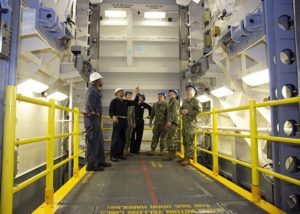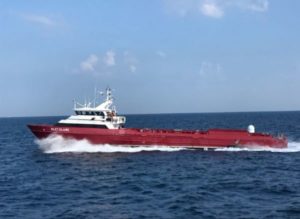An amendment to the House Armed Services Committee’s markup of the fiscal year 2021 defense authorization bill Tuesday directs a report on naval subsystem technology development, echoing similar Senate concerns.
The House Armed Services Committee approved an en bloc set of amendments concerning the seapower subcommittee’s portion of the bill via voice vote.

One amendment in the group sponsored by Rep. Elaine Luria (D-Va.) would direct the Secretary of the Navy to submit a report to the congressional defense committees “detailing the number of times the Navy has accepted a ship prior to the incorporation and completion of major subsystems over the last twenty years, the circumstances that drove the Navy to accept such ship, and the length of time between acceptance and final incorporation of such subsystems,” the amendment report said.
The provision also directs the report to “specifically assess emerging technologies, their associated technology readiness levels and required prototyping activities that are being incorporated in emerging programs.” This includes the Columbia-class ballistic missile submarine, large surface combatant, and large unmanned surface vessel.
The amendment summary underscored ongoing delays with the USS Gerald R. Ford (CVN-78) and its several new technologies “may indicate systemic problems with Navy shipbuilding practices with how new technologies are developed and incorporated.”
It specifically noted the Advanced Weapons Elevator (AWE) was not prototyped before being incorporated on the lead ship, leading to numerous delays.
“The committee is concerned with the Navy’s decision to accept a ship that still had major discrepancies.”
In February 2019, then-commander of Naval Sea Systems Command Vice Adm. Thomas Moore revealed the Navy planned to build a new land-based test site for the AWEs after dealing with various installation delays on the lead ship (Defense Daily, Feb. 20, 2019)
“We would have been better, frankly, to have a land-based test site for the weapons elevators on Ford,” he said. “If that had been the case we wouldn’t be where we are today, I’m convinced of that.”
Moore added the Navy would preferably have built the facility in 2008. The Navy later said the decision was made in FY 2015 and design work began in February 2016 (Defense Daily, March 6, 2019).
The amendment summary said given issues experienced with the Ford’s new technology and the Navy’s plans for more in vessels like unmanned surface vessels it said the committee supports expanding prototype activities to ensure new technology reliability before ship authorization.
The Senate’s version of the FY 2020 defense authorization bill also seeks limits on using new technology too quickly. It requires the Navy to qualify the main engines and generators for unmanned vessels before procurement starts (Defense Daily, June 11).
SASC aides told reporters the committee is trying to require technological maturity and have the Navy pursue more subsystem prototyping before moving ahead with unmanned vessel production.
SASC also wants the Navy to fully use land-based testing sites for these purposes.

A recent article by Senate Armed Services chairman Sen. Jim Inhofe (R-Okla.) and Ranking Member Jack Reed (D-R.I.) in Proceedings in June elaborated on their goals in the area.
“We believe this is a critical juncture and opportunity for all of us to do better on lead ships. To this end, we call for…the return to an Aegis-type development model in which critical subsystems are matured before the Navy procures the lead ship of a new class.”
Under this view, development should be based on a detailed understanding of the systems engineering needed to mature subsystems and the technical integration needed to reach overall platform performance.
The senators warned that “without such an approach, we are convinced the cost overruns, schedule delays, and substandard performance that have defined Navy lead-ship development over the past two decades will continue. It does not have to be this way.”
Inhofe and Reed identified four principles that should guide lead ship development: DoD leaders should define the future force architecture and sign off on realistic system and subsystem-level plans, new critical subsystems should be proven before building a full-scale platform with prototyping to prove it meets at least minimum requirements, contracting for a full-scale platform prototype should only occur after all critical subsystems have been proven and focus on system integration, and the objective of subsystem and full-scale platform prototyping is to close the government’s technical knowledge gaps.
They argued government and industry leaders should recognize speeding up research and getting capabilities faster requires demonstration of subsystems first.
“Rather than delaying new programs, we believe this approach will enable the delivery of capable, reliable, and sustainable platforms that meet the needs of military commanders faster than would otherwise occur.”